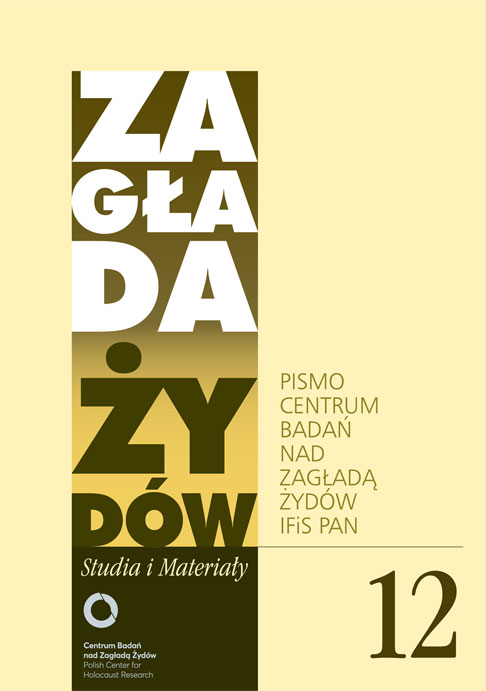Kindertransporty – brytyjskie akcje ratowania żydowskich dzieci w latach 1938–1939
Zagłada Żydów. Studia i Materiały, Nr 12 (2016), Strony: 141-168
Data zgłoszenia: 2020-10-19Data publikacji: 2016-11-30
 https://doi.org/10.32927/ZZSiM.412
https://doi.org/10.32927/ZZSiM.412
Abstrakt
The article talks about Kindertransports – the major rescue action organized by British-Jewish organizations, and run from the territory of Great Britain between 1938 and 1939. The Kindertransports aimed at gathering and sending to Great Britain Jewish children under the age of seventeen, in order to prevent them from witnessing, or being victims of the acts of violence in Nazi controlled Europe. Once in Great Britain, the children were supposed to spend several weeks with British families willing to give them shelter and support. Those for whom foster parents would not be found, were to be sent to boarding schools or temporary shelters. In the action’s planning phase the institutions involved considered the Kindertransports to be a temporary solution. As the situation of the Jewish population in Nazi controlled Europe worsened, it became clear that the character of the action needed to be revised, and the families were expected to guest the children for a longer and unspecified time. In the end approximately 10.000 Jewish children, who travelled to the Isles, were allowed to stay throughout the times of war. In 1945 it became clear that vast majority of them had no place or family to get back to. They stayed in Great Britain becoming an important and vital part of the British society, with British citizenships granted shortly after the end of the war. The article discusses the organization of the Kindertransport and talks about other solutions taken under consideration both by the program organizers, and the British government. It elaborates on the experiences the children shared, that is being separated from their families, feeling homesick, or finding oneself in the new environment. It explains the question of the lost identity of the participants of the program and speaks on how the subjects dealt with it. It also shows how the British legislature and laws connected to the Enemy Alien status together with the Defence Regulation 18B influenced lives of the underage survivors. The article ends with an attempt of estimation of what happened to the Kindertransport children after the war. How many of them remained in Great Britain and considered themselves British, how many shown high level of mobility and spend their lives changing their place of residence. In the end how many of them kept their self-identification as Jews, and how many converted.
Słowa kluczowe
Kindertransporty , Zagłada , Wielka Brytania , Trzecia Rzesza , akcja pomocowa , ratowanie , dzieci , ocaleni , Żydzi
Licencja
Prawa autorskie (c) 2016 Autor&"Zagłada Żydów. Studia i Materiały"

Utwór dostępny jest na licencji Creative Commons Uznanie autorstwa 4.0 Międzynarodowe.
https://creativecommons.org/licenses/by/4.0
Czasopismo publikowane jest w standardzie Diamond Open Access na licencji CC-BY-4.0 Deed - Uznanie autorstwa 4.0 Międzynarodowa - Creative Commons
Podobne artykuły
- Dariusz Libionka, Jak hochsztaplerów na wyklętych przerobić. Uwagi o filmie "Tora i miecz" , Zagłada Żydów. Studia i Materiały: Nr 12 (2016)
- Jan Tomasz Gross, Czy Zagłada jest ich historią, czy naszą? (Plaidoyer w przedmiocie ustanowienia w Polsce miejsca pamięci poświęconego Zagładzie) , Zagłada Żydów. Studia i Materiały: Nr 13 (2017)
- Nawojka Cieślińska-Lobkowicz, O wystawie „Czego nie mogliśmy wykrzyczeć światu” w Żydowskim Instytucie Historycznym w Warszawie , Zagłada Żydów. Studia i Materiały: Nr 14 (2018)
- Jacek Leociak, Cenzor na straży Kościoła. Ocenzurowany pamiętnik Krystyny Modrzewskiej , Zagłada Żydów. Studia i Materiały: Nr 5 (2009)
- Klaus Peter Friedrich, Nazistowski mord na Żydach w prasie polskich komunistów (1942–1944). , Zagłada Żydów. Studia i Materiały: Nr 2 (2006)
- Stanisław Obirek, Dialog chrześcijańsko-żydowski z Zagładą w tle , Zagłada Żydów. Studia i Materiały: Nr 5 (2009)
- Jan H. Issinger, Frankenstein w warszawskim getcie. Historia i legenda , Zagłada Żydów. Studia i Materiały: Nr 12 (2016)
- Dariusz Libionka, Od Redakcji , Zagłada Żydów. Studia i Materiały: Nr 19 (2023)
- Barbara Engelking, Labirynty i plątaniny. Historia pewnego Sprawiedliwego , Zagłada Żydów. Studia i Materiały: Nr 11 (2015)
- Anna Bikont, „W sprawie zamordowania rodziny mojej…”. , Zagłada Żydów. Studia i Materiały: Nr 19 (2023)
<< < 4 5 6 7 8 9 10 11 12 13 14 15 16 17 18 19 20 21 22 23 24 25 26 27 28 29 30 31 32 33 34 35 36 37 38 39 40 41 42 43 44 45 46 47 48 49 50 51 > >>
Możesz również Rozpocznij zaawansowane wyszukiwanie podobieństw dla tego artykułu.
 English
English
 Język Polski
Język Polski



 https://orcid.org/0000-0003-0053-6000
https://orcid.org/0000-0003-0053-6000

